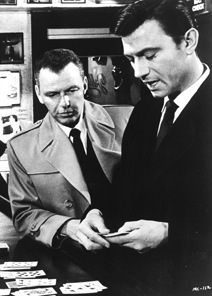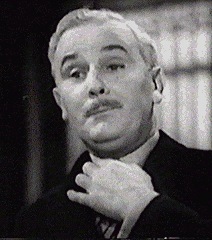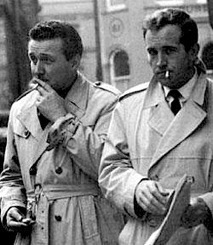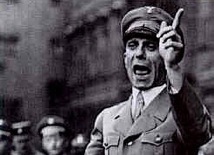Nazi propaganda minister Joseph Goebbels is generally cited as the author of the “big lie” technique: Repeat a lie often enough and it becomes widely accepted as the truth. The idea is at least as old as Machiavelli, though Adolf Hitler may actually have coined the phrase in Mein Kampf. Hitler, Lenin and Stalin were acknowledged masters of the big lie, as were the rulers of George Orwell’s dystopias.
Fictional spy entertainment has its own big lies. It’s often difficult to pin down who started them, but they continue to circulate in fan circles and mainstream publications alike. Some examples:
The extraordinary 1962 spy thriller/political satire “The Manchurian Candidate” was withdrawn from circulation after JFK’s assassination by its distraught producer-star Frank Sinatra and went unseen for 30 years.
Sorry, never happened. It makes a good story, given Sinatra’s well-publicized association with the Kennedys. In the numbing wake of the president’s death, the emotional Sinatra might have impulsively decided he didn’t want anyone to see the film, with its elaborate plot to brainwash Laurence Harvey’s character into assassinating a presidential candidate. But he didn’t. It’s doubtful he had the power to do so even if he had wanted to.
“The Manchurian Candidate” simply followed the standard 1960s afterlife of motion pictures. It was released in October 1962, so it was long out of theaters when Kennedy was killed 13 months later. It was then sold to television like most other movies at the time, since the networks were having great success airing recent, popular films in prime time and were adding movie nights every year.
When CBS joined NBC and ABC in scheduling a weekly movie slot beginning Sept. 16, 1965, the widely promoted premiere attraction was — guess what — “The Manchurian Candidate.” Almost two years after Kennedy’s assassination, there was no hue and cry over a national telecast of the movie. Everyone had long since gotten over the immediate impact and gone on with their lives, with the possible exceptions of future filmmaker Oliver Stone and the element that lives to prove the Warren Commission covered up a huge conspiracy. The film aired several times on CBS, then went over to NBC where it aired again as late as April 27, 1974 (an indication of the movie’s continued popularity — by that time the networks rarely screened black-and-white films).
James Bond author Ian Fleming also created The Man From U.N.C.L.E.
No, he didn’t.
Well, then, Ian Fleming used the name Napoleon Solo for a villain in Goldfinger, then he sold the name to the producers of The Man From U.N.C.L.E.
Oh, good grief.
Honestly, does any of that even sound reasonable? Of course not. The “Mr. Solo” in Goldfinger was a Mafia chieftain. He was not Napoleon Solo. He had no first name. He was simply Mr. Solo in the novel and in the movie. Fleming’s only contribution to the project that became The Man From U.N.C.L.E. was naming the hero Napoleon Solo. Apparently he just forgot, or honestly didn’t think it was such a big deal, that he had used the surname for a minor character in one of his novels. Bond film producers Harry Saltzman and Cubby Broccoli tried to make it a big deal, but the only result of their threats to sue was an agreement to change the series title from Solo to The Man From U.N.C.L.E.
Author Ian Fleming, creator of James Bond, also made cameo acting appearances in spy shows.
Well, sure he did. And he enjoyed it so much, he even continued making these appearances after he was dead.
This one’s a great example of people who have no idea what they’re talking about convincing themselves they’ve made a fantastic discovery while never stopping to consider the obvious truth, which is:
There was a British actor named Ian Fleming, whose career spanned five decades on stage, screen and television. He was fairly well known in the U.K. long before Fleming the author gained any notoriety from the Bond books, primarily for playing Dr. Watson in a popular series of Sherlock Holmes movies made in England in the 1930s, with Arthur Wontner as Holmes. Some of these Holmes films were released in the U.S.
Coincidentally, actor Fleming also appeared in Cubby Broccoli’s 1960 production, “The Trials of Oscar Wilde,” made just before Broccoli teamed with Harry Saltzman to produce the James Bond movies. He was also in the 1948 British picture “Quartet” that dramatized four Somerset Maugham stories, with future Bond film stars Bernard Lee and Honor Blackman.
But the popular and widely referenced volume The Complete Directory to Prime Time Network TV Shows by Tim Brooks and Earle Marsh, in its entry for the series Espionage, claims that Fleming the James Bond author appeared in an episode of that British-made show. It’s rather astonishing that Brooks and Marsh could be so naïve that they jumped to the conclusion that author Fleming turned actor when they came across the name in a cast list somewhere. But they did, and equally ignorant writers cite them when further spreading this big lie.
Even more surprisingly, TV Guide ran a story in 1983 about the ever-growing popularity of The Prisoner, and this story claimed that James Bond’s creator also appeared in an episode of that show. Of course, the story did not explain how a man who died in 1964 appeared in a show made in 1967 (and when I pointed out the error they didn’t want to hear it). Fleming appeared in the episode “The General,” by the way.
Fleming the actor continued working in such minor roles in British TV and films throughout the 1960s (he also appeared in the 1965 spy film “The Return of Mr. Moto”). He died in England in 1969.
Agent 99’s real name is Susan Hilton.
Another example of careless writers and impetuous fans leaping on a “revelation” without waiting to hear the explanation — unless they just possibly were innocent victims of a syndicated rerun that cut the explanation.
This one stems from a single third-season episode of Get Smart, “99 Loses Control,” in which 99 decides that Max will never love her and tearfully resigns from Control to marry a suave gambler named Royal who operates a casino (Royal’s Casino, get it?). She tells her fiancé and Max that her name is Susan Hilton — until the tag, when she tells Max that’s not her real name (after Royal is exposed as a KAOS agent and 99 returns to Max and Control).
It’s just possible that years ago in syndicated reruns, some stations cut this part of the tag, or the entire tag. But with recent, relatively intact cable runs and the availability of the uncut shows on DVD, there’s no excuse to keep circulating this one.
“Call to Danger” was the pilot for Mission: Impossible.
This is another inexplicable Brooks and Marsh canard that appears in edition after edition of The Complete Directory to Prime Time etc. (under the listing for Premiere, a 1968 summer series made up of busted pilots). They and other supposed TV experts make this ridiculous claim, never asking themselves the obvious question: Steven Hill was the star of Mission: Impossible’s first season; Peter Graves succeeded him in the second season; so what would Peter Graves be doing in the pilot for Mission?
Mission: Impossible’s pilot starred Steven Hill. It was produced at Desilu by series creator Bruce Geller. “Call to Danger” starred Peter Graves. It was created by Perry Lafferty and produced as an in-house pilot for CBS. There is absolutely no connection between the two.
The Avengers was a spin-off from Ian Hendry’s earlier series Police Surgeon.
Wrong, but at least the origins of this lie are easier to understand, especially in the United States where Police Surgeon and the first years of The Avengers were unknown. Actually, Police Surgeon was a half-hour drama that ran from September to December 1960 on the U.K.’s commercial network, ITV. It was produced by ABC — a British company that was one of ITV’s major program suppliers at the time, not to be confused with the American network of the same initials. The series was not successful but its star Ian Hendry was thought to have great possibilities. So ABC created a new series for Hendry, which was, of course, The Avengers, a one-hour show with Patrick Macnee as his co-star.
The only similarity between the two series is that Hendry played a doctor in both. But in Police Surgeon he was Dr. Geoffrey Brent, a medico attached to the London police force. In The Avengers he was Dr. David Keel, a physician in private practice. If the Dr. Brent character had continued in The Avengers, then that show would indeed have been a spin-off of Police Surgeon. But he didn’t, and it isn’t.
The Avengers episode “A Touch of Brimstone” was banned in America.
Another great story, and another case of the truth being nowhere near as sensational. This one seems to have started in the U.K., where every detail of The Avengers has been lovingly examined but facts about the show’s American broadcasts remain surprisingly fast and loose. As everyone knows, when Diana Rigg joined The Avengers as Mrs. Emma Peel, the show produced a new series of 26 episodes and those were shot on film instead of video tape, a move that finally got the show sold in America.
ABC bought The Avengers in November 1965 but had no timeslot available until Ben Casey completed its fifth and final season in March 1966. ABC put on The Avengers in lieu of Casey reruns, airing 21 episodes from March 28 through Sept. 1. Then the new TV season started and five episodes never got on the air (leading some writers to claim that all five were “banned”). One of these five was indeed the so-called banned episode, “A Touch of Brimstone,” the one in which a band of rowdies dress Mrs. Peel as “the queen of sin,” replete with Victorian corset, high-heeled boots, spiked dog collar and a huge, live snake writhing about her body. The chief villain also takes a whip to her. And yes, that was all a bit much for 1966 American television, so when ABC chose five episodes not to run, naturally that was one of them. But it was hardly “banned.”
“A Touch of Brimstone” went into syndication in 1969 with every other episode of The Avengers, including the other four that ABC never ran, and aired weekday afternoons to absolutely no comment. It also should be noted that the American networks often failed to air every episode of the British series they bought. And in fact that “queen of sin” sequence had to be cut slightly to get on the air in Britain in 1966.
Just for the record, the other episodes ABC did not run are “Honey for the Prince” (containing another risqué sequence with Mrs. Peel undercover in a harem), “A Surfeit of H2O” (which I suppose might have offended a few Bible Belt viewers with its fire-and-brimstone character building an ark to survive another Great Flood), “Silent Dust” (chemical warfare!) and “Quick-Quick Slow Death” (a completely inoffensive episode about a dance school that smuggles enemy agents into Britain).
The Name Game
The actor recently forced to vacate the role of James Bond after starring in four movies is Pierce Brosnan. That’s Brosnan, not “Bronson.”
The star of The Man From U.N.C.L.E. was Robert Vaughn. Not “Vaughan.” He played Napoleon Solo. That’s Napoleon as in Bonaparte, not “Napolean.” Vaughn’s co-star was David McCallum, not “MacCallum,” “McCullum,” “Macallum,” or any other variation. He played Illya Kuryakin. His name was not “Ilya,” even though that is the more common Russian spelling. And Kuryakin? I couldn’t begin to list the number of ways that’s been misspelled over the years.
The star of The Girl From U.N.C.L.E. was Stefanie Powers. That’s Stefanie, not Stephanie (her real first name is Stefania).
The star of The Avengers was Patrick Macnee. Not “MacNee.” Not “McNee.” He played John Steed, not “Jonathan” Steed (I’ll never know where that one started). His co-star was Diana Rigg, not “Riggs.” She was succeeded by Linda Thorson, not “Thorsen.”











